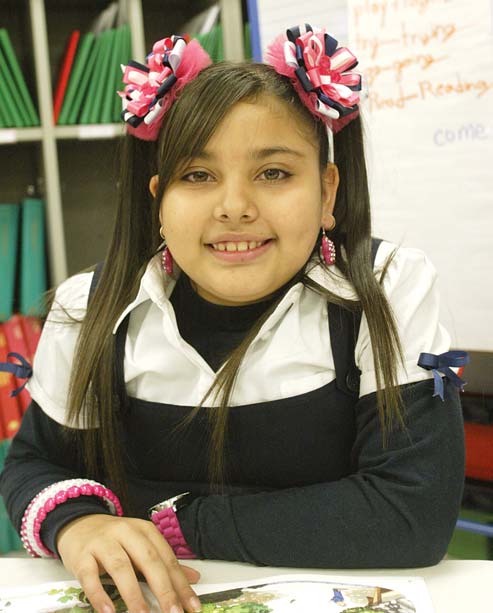Youngstown schools break down students’ language barriers

Aleishka Rodriguez, a fourth-grader at Youngstown’s Martin Luther King Jr. Elementary School, enrolled in the school as a second-grader speaking Spanish. Now, with help from her teacher, Joan Fahey, others at the school and family members, Aleishka speaks English fluently. About 250 students participate in the city schools’ English language learners program for students who speak other languages.
By DENISE DICK
denise_dick@vindy.com
YOUNGSTOWN
Deanna Beauchamps came to the city at 15, speaking no English.
Ten years later, she’s an educational assistant at Martin Luther King Jr.
Elementary School in Youngstown, helping non-English speaking students learn the language.
“I went through it,” Beauchamps said. “I know what it is to come and to feel scared and overwhelmed when everybody around you is speaking a language that you don’t understand.”
Each year, about 250 city school children are part of the district’s English language learners program, according to Alida Treharn, supervisor of state and federally funded programs for the district.
When they enroll in the district, students with limited English skills take a test to determine their English language proficiency. The results of that test determine how students are instructed.
The younger children generally pick up the new language more quickly, Treharn said. Older students may struggle more.
Aleishka Rodriguez, 9, is a fourth-grader at Martin Luther King, and came to the city two years ago speaking little English.
Although she’s shy with strangers, Aleishka now speaks English like a native.
Teacher Joan Fahey said Aleishka passed all sections of the Ohio Achievement Assessment last year.
“She has great parental support,” Fahey said.
Aleishka’s stepfather is bilingual so the family communicates in both English and Spanish.
Aleishka says she thinks in both languages too.
In elementary schools, English-language learners students are clustered by grade level. When the regular classroom teachers work with students in language arts, Teachers of Students of Other Languages pull out from the regular class to work with them.
Additional educational assistants, who are bilingual, follow students in grades two through 12.
At high school, students are spread among classes rather than clustered.
Beauchamps was a junior when she came to the former Woodrow Wilson High School from Puerto Rico, speaking Spanish.
“It was scary,” she said. “It was overwhelming.”
The first year, she had an educational assistant with her during the school day, translating. Her senior year, though, she was on her own as there was a shortage of available personnel.
She passed all parts of the proficiency test in English and graduated on time in 2003.
“I always said I was going to be a teacher and then when I turned 18, they had some positions available, so I thought, why not start working with the kids,” said Beauchamps.
She earned a degree in accounting and is pursuing her teaching degree at Youngstown State University with plans to be a math teacher.
Beauchamps credits teacher Saedah Hadi with much of her success.
Hadi now teaches at East High School.
Students Miguel Cintron, Wilmarie Rosa, both seniors, and sophomores Siomaralis Alvira Mercado and Jancarlos Lebron are in Hadi’s class, and each one’s English is at a different level. Each came to the city from Puerto Rico.
Siomaralis relies heavily on an interpreter while Wilmarie converses fluently.
It was intimidating, at first, Miguel said of coming to a school where he didn’t speak the language.
“I listened to people talking in English all around me,” he said.
His father speaks English but at home, Miguel speaks Spanish.
Wilmarie spoke some English when she came to the city about a year ago. Both her mother and older sister speak English, helping her when she needs it.
But she still slips back into her native tongue occasionally.
“When I get nervous, I start speaking Spanish,” she said.
Jancarlos says sometimes it’s easier to write and read in English than to speak the language.
While in school, the students hang out together and eat lunch as a group. When a new student, who doesn’t speak English, enters school other students try to help him or her.
“We’re like a family,” Miguel said.
Hadi, who is fluent in Spanish, English and Arabic, said there are four educational assistants at the school that work with the students. While this year all of the students enrolled are native Spanish speakers, previous years have seen Thai and Arabic speakers.
How quickly a student learns to speak in English depends somewhat on whether anyone at home speaks the language.
Wilmarie, for example, whose mother and sister speak English, communicates easily.
Beauchamps enjoys her job helping others who face the same challenges she did as a teenager.
“I’m just blessed to be here,” she said.
 43
43
